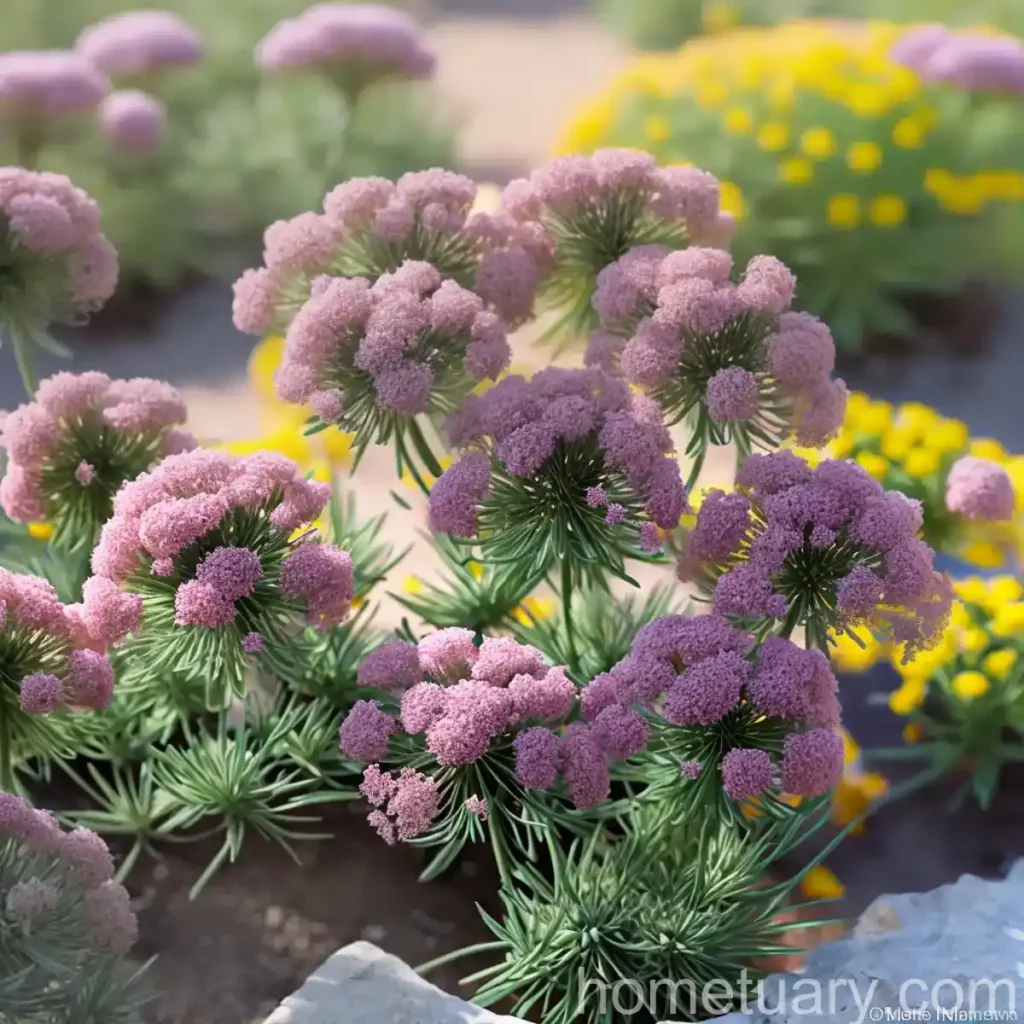Sulphur Flower (Eriogonum umbellatum): A Rocky Mountain Wildflower
What is Sulphur Flower (Eriogonum umbellatum)?
Sulphur flower, scientifically known as Eriogonum umbellatum, is a dazzling wildflower native to the American West, particularly the Rocky Mountains. This perennial plant is also commonly referred to as yellow wild buckwheat. It is a treasured component of the western flora, thriving in high-elevation regions with rocky soils. The plant is well adapted to the harsh mountain environment, making it a symbol of resilience and sustainability. Moreover, its brilliant yellow blooms make it an essential species for pollinators and wildlife, contributing to the biodiversity and ecosystem health of its native habitat.
Key Takeaways – Sulphur Flower (Eriogonum umbellatum)
Sulphur flower, also known as Eriogonum umbellatum, is a significant species for various aspects of sustainable gardening, natural landscaping, and ecosystem conservation. Key takeaways about this plant include:
- Native plant species of the American West, particularly the Rocky Mountains
- Perennial plant known for its vibrant yellow flowers
- Thrives in high-altitude and rocky soil environments
- Adapted to drought conditions, making it a drought-tolerant plant
- Supports pollinators and wildlife, making it a valuable component of the ecosystem
- Medicinal uses and cultural significance within indigenous communities
- Suitable for low-water gardening, xeriscaping, and eco-friendly landscaping
- Essential for native plant conservation, restoration, and planting for biodiversity
This article aims to provide comprehensive insights into the cultivation, care, and ecological significance of sulphur flower, addressing its cultural uses, water, sunlight, fertilizer, soil, pruning, propagation, container gardening, common diseases, and pests. Additionally, it will explore the plant’s ecological and medicinal roles, along with helpful tips for gardening enthusiasts and conservation practitioners.
Culture
Uses
Sulphur flower (Eriogonum umbellatum) serves various cultural, ecological, and medicinal purposes, making it a multifaceted plant that contributes to the well-being of both the environment and human communities. Its uses include:
- Cultural Significance: The plant holds cultural significance within indigenous communities, where it may have ceremonial, spiritual, or traditional uses.
- Medicinal Uses: Some tribes and indigenous groups have utilized sulphur flower in traditional medicine for treating specific ailments.
- Ecological Importance: As a native plant species, sulphur flower plays a vital role in maintaining the health of its native ecosystem, providing food and habitat for various wildlife and pollinators.
Water
Sulphur Flower’s Water Needs
Sulphur flower, being a drought-tolerant plant, is well adapted to low-water conditions once established. However, adequate watering is crucial during its establishment phase and in extended periods of drought to ensure healthy growth and prolific flowering.
Watering Guidelines:
– Establishment Phase: Water newly planted sulphur flowers regularly to support root development and establishment.
– Mature Plants: Once established, reduce watering to mimic the natural rainfall patterns of its native environment.
– Drought Conditions: During prolonged dry periods, provide supplemental watering to prevent stress and maintain flower production.
Sunlight
Optimal Sunlight for Sulphur Flower
Sulphur flower thrives in full sunlight, characteristic of its native rocky mountain habitat. Adequate exposure to sunlight is essential for the plant’s overall health, flower production, and resilience.
Sunlight Requirements:
– Full Sun: Plant sulphur flower in locations that receive at least 6-8 hours of direct sunlight per day for optimal growth and flowering.
– Shade Tolerance: While the plant prefers full sun, it can tolerate light shade, especially in exceptionally hot climates, albeit with potentially reduced flowering.
Fertilizer
Fertilizing Sulphur Flower
Fertilizer application for sulphur flower should be approached cautiously, as the plant is well adapted to nutrient-poor, rocky soils. Excessive fertilization can lead to an imbalance and may hinder the plant’s natural resilience.
Fertilizer Guidelines:
– Minimal Fertilization: Due to its preference for poor soils, avoid excessive fertilization.
– Organic Matter: Incorporating organic matter into the soil during planting can provide a gentle nutrient boost without overwhelming the plant.
– Balanced Fertilizer: If necessary, apply a balanced, low-nitrogen fertilizer sparingly in early spring to support initial growth.
Soil
Ideal Soil Conditions for Sulphur Flower
Sulphur flower thrives in rocky, well-draining soils, reflecting the harsh conditions of its native mountainous habitat. Understanding its soil preferences is crucial for successful cultivation.
Soil Requirements:
– Rocky Soils: Mimic the plant’s native environment by providing a well-draining, rocky or gravelly soil medium.
– Soil pH: While adaptable to a range of pH levels, a slightly acidic to neutral soil (pH 6.5-7.5) is optimal for sulphur flower.
– Poor Fertility: Avoid nutrient-rich soils, as sulphur flower is adapted to low-nutrient conditions, and high fertility may adversely affect its growth.
Pruning
Pruning Techniques for Sulphur Flower
Routine pruning is generally unnecessary for sulphur flower, as it naturally maintains a compact and tidy growth habit. However, minimal maintenance pruning may be beneficial for aesthetics and plant health.
Pruning Guidelines:
– Deadheading: Remove spent flowers to promote continuous blooming and maintain the plant’s appearance. It can also prevent self-seeding in cultivated areas.
– Trimming: Light trimming of damaged or overly leggy growth can be performed in late fall or early spring to rejuvenate the plant.
Propagation
Propagating Sulphur Flower
Propagating sulphur flower can be achieved through multiple methods, allowing enthusiasts and conservationists to expand its presence in gardens and natural landscapes.
Propagation Methods:
1. Seed Propagation: Collect ripe seeds in late summer and sow them directly into well-prepared, rocky soil for natural germination in the following spring.
2. Division: In early spring, divide mature plants by carefully separating the root ball and replanting the divisions in suitable locations.
Container
Growing Sulphur Flower in Containers
Sulphur flower can be cultivated successfully in containers, allowing gardening enthusiasts with limited space or unsuitable soil conditions to enjoy its beauty and ecological benefits.
Container Guidelines:
– Container Size: Choose a container with sufficient depth and adequate drainage holes to mimic the plant’s preference for well-draining soil.
– Soil Mix: Utilize a well-draining, rocky soil mix or cactus/succulent potting mix to replicate the plant’s native habitat.
– Sun Exposure: Position the container in a location with full sunlight, providing the plant with the optimal light conditions.
Popularity
Popularity of Sulphur Flower in Gardening
Sulphur flower, with its vibrant blooms and ecological significance, has gained popularity among gardening enthusiasts and conservation advocates, contributing to its increased presence in various landscape designs, gardens, and natural habitats.
Gardening Appeal:
– Native Landscaping: As a native plant of the American West, sulphur flower is an essential component of natural and native landscaping projects.
– Xeriscaping: Its drought-tolerant nature and low-water requirements make it an attractive choice for xeriscaping initiatives and sustainable gardening.
– Wildlife Gardens: Sulphur flower’s role in supporting pollinators and wildlife enhances its appeal for creating wildlife-friendly gardens.
Common Diseases
Disease Resistance and Vulnerabilities
Sulphur flower exhibits overall resistance to common plant diseases, owing to its adaptation to harsh and nutrient-poor environments. However, occasional issues may arise, particularly in overly wet or humid conditions.
Common Diseases:
– Powdery Mildew: In humid conditions, sulphur flower may be susceptible to powdery mildew, leading to white powdery patches on the foliage.
– Root Rot: Excessive moisture can cause root rot in sulphur flower, emphasizing the importance of well-draining soil and appropriate watering practices.
Disease Diagnosis
Detecting and Addressing Plant Diseases
Early diagnosis and prompt treatment are essential for managing and preventing the spread of diseases in sulphur flower, safeguarding its health and vitality.
Diagnosis and Management:
– Visual Symptoms: Regularly inspect the plant for any signs of abnormal discoloration, wilting, or powdery residues on the leaves.
– Proper Air Circulation: Ensure adequate spacing between plants and proper air circulation to mitigate humid conditions, reducing the risk of fungal diseases.
Common Pests
Pest Resilience and Management
Sulphur flower generally demonstrates resilience to pests, a testament to its adaptation to challenging mountain environments. However, occasional pest presence may require attention.
Potential Pests:
– Aphids: These tiny, sap-feeding insects may occasionally affect the plant, particularly during periods of new growth. Natural predators and horticultural oils can help manage aphid populations.
– Spider Mites: In hot and dry conditions, spider mites may infest the plant, leading to webbing and stippling on the foliage. Regularly inspect the plant and rinse with water to deter spider mite infestations.
Botanist’s Tips
Expert Tips for Growing Sulphur Flower
As an iconic wildflower of the American West, sulphur flower can thrive with proper care and consideration of its ecological preferences. Here are some expert tips for cultivating and appreciating this stunning plant:
Botanist’s Advice:
– Native Plant Conservation: Embrace native gardening practices and support the conservation of native plant species, including sulphur flower, to preserve biodiversity.
– Wildlife Support: Utilize sulphur flower and other native plants to create wildlife-friendly landscapes, promoting pollinator and wildlife habitat conservation.
– Sustainable Landscaping: Incorporate sulphur flower into sustainable landscaping initiatives, such as xeriscaping and low-water gardening, to minimize environmental impact.
Fun Facts
Fascinating Quirks of Sulphur Flower
Beyond its ecological and cultural significance, sulphur flower exhibits intriguing characteristics and ecological interactions that enhance its allure and appeal for nature enthusiasts.
Engaging Facts:
– Pollinator Magnet: The brilliant yellow blooms of sulphur flower attract a myriad of pollinators, including bees, butterflies, and other beneficial insects.
– Medicinal Significance: Among indigenous communities, sulphur flower may have traditional medicinal uses, representing its cultural and historical importance.
– Ecosystem Role: Through its ecological interactions, sulphur flower contributes to the resilience and vitality of its native ecosystem, embodying the interconnectedness of species in nature.
Links to External Resources
For further information on Sulphur Flower (Eriogonum umbellatum), its cultivation, ecological significance, and conservation, the following external resources provide valuable insights and guidance:
- National Park Service – Wildflowers
- Lady Bird Johnson Wildflower Center
- American Society of Landscape Architects – Sustainable Design
- The Xerces Society for Invertebrate Conservation
These resources offer a wealth of knowledge on native plant species, sustainable gardening practices, wildlife conservation, and the medicinal uses of native plants, enriching the understanding of Sulphur Flower and its role in ecological stewardship and biodiversity conservation.
Conclusion
Sulphur flower (Eriogonum umbellatum) stands as a remarkable emblem of the American West, showcasing its versatility and significance in native gardening, sustainable landscaping, and ecosystem conservation. As a high-elevation, drought-tolerant wildflower, it embodies resilience and ecological interconnectedness, providing essential habitat and forage for pollinators and wildlife. Its cultural uses and potential medicinal applications further underscore its multifaceted importance. By integrating sulphur flower into native plant gardens, xeriscapes, and wildlife habitats, individuals can contribute to the preservation of biodiversity and the resilience of natural ecosystems. Understanding the cultivation, care, and ecological role of sulphur flower allows us to appreciate and safeguard this iconic wildflower for generations to come.
Note: This article is intended for informational purposes only and does not replace professional advice. Ensure that you research and consult horticultural experts and authoritative sources for specific cultivation and ecological guidance.















